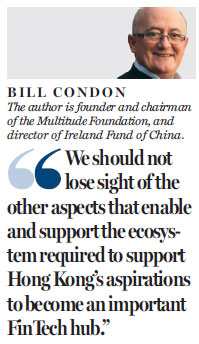Finding gold on the Maritime Silk Road
Updated: 2016-02-16 09:53
By Luis Liu(HK Edition)
|
|||||||
The central government's Belt and Road Initiative offers renewed hope for revival of HK's flagging economy, with the tourism industry among its most avid supporters, Luis Liu reports.
As Hong Kong businesses get ready to respond to the Chief Executive Leung Chun-ying's call to climb on board the central government's Belt and Road Initiative, the city's struggling tourist industry hopes to lead the way, bringing new business to the city. Leung, in citing the Belt and Road Initiative more than 40 times in his Policy Address, singled out the tourism industry as one of the early beneficiaries of the initiative.
The CE evoked images of a major shift in the tourism sector: expansion to new markets, bringing new visitors to revive an industry which has become almost wholly dependent on faltering numbers of mainland tourists.
A detailed blueprint setting out how this is to be accomplished still has to be worked out among the different levels of government.
Hong Kong Tourism Board (HKTB) statistics show that last year, the number of tourist visitors to Hong Kong fell for the first time since 2003, the year the SAR government introduced the Individual Visit Scheme, to revive the local economy after the SARS epidemic. The 2015 numbers fell to 59.3 million, down 1.5 million from the record setting 60.8 million in 2014.
There were some positive signals in last year's figures, however. There was a 5 percent increase in the number of visitors from Southeast Asia, which plays a major part in the Belt and Road Initiative, aimed at promoting greater international economic cooperation and integration. In December 2015 alone, tourist arrivals from South Asia and Southeast Asia surged 8.9 percent over the previous year. The December figures for North Asia were even more promising, increasing by 6.7 percent, HKTB statistics showed. The November numbers were better still. Visits from South and Southeast Asia climbed 13.9 percent. Tourism from North Asia increased 11.9 percent.
Take a break in HK
Joseph Tung Yiu-chung, executive director of the Travel Industry Council, foresees great potential in new markets. As a unique city of China, Hong Kong offers its own charm, Tung said. He suggested a useful strategy would be to include Hong Kong in a coordinated China tourism program, rather than setting the city on an independent course.
China is renowned for its abundant attractions for tourists, from breathtaking landscapes to remnants of its ancient cultures, Tung said. "Hong Kong is in the best position to serve as a stop, that shows a city under a special system, having passed through a unique chapter of history," he added.
He urged the National Tourism Administration (NTA) to coordinate with the SAR as early as possible, adding there already is consensus among the local tourism industry for joining a national scheme.
Leading tourism expert Song Haiyan offered a somewhat different perspective, however. He urged that the city diversify its approach to attracting visitors. He listed world-class music and sporting events, and resorts dedicated to eco-tourism. Song, the associate dean (Research) and chair professor at Hong Kong Polytechnic University's School of Hotel and Tourism Management, emphasized Hong Kong's status as a regional transport hub. The city has strong assets: beautiful seascapes and a landscape with 70 percent being green space. Developing and integrating these assets, he said, would be the most feasible route to upgrading the city's tourism assets.
Song proposed expanding cruise ship traffic as a first step.
A spokesman for the Hong Kong Tourism Commission agreed that developing multi-destination cruise tourism would be decisive in capitalizing on the Belt and Road Initiative. Hong Kong would cooperate with nearby ports, developing new routes and expanding Asia's cruise market overall. The "Asia Cruise Fund" founded by the HKTB in 2014 already has established partnerships with Taiwan, the Philippines and other ports encompassed by the 21st Century Maritime Silk Road, including Xiamen and Hainan, according to the spokesman. The HKTB continues its dialogue with other port cities in Asia, encouraging them to join the partnership. The spokesman added that the Hong Kong government will help to develop these travel links for Hong Kong travelers, encouraging more people-to-people exchanges between Hong Kong and other cities along the routes.
Ripe for growth
These initiatives, once firmly established, would create opportunities for new enterprises focused on tourism. Yiu Si-wing, lawmaker representing the tourism industry, noted that Hong Kong's established reputation for high quality service and management will play a significant role. He said that a national-level partnership will provide fresh opportunities for Hong Kong investors and management companies, including expansion of financial services, to new travel destinations.
As countries and regions in the network become involved in large scale infrastructure construction, including air transport facilities, the free flow of visitors to various destinations will be vastly improved. For this reason, analysts suggest that the financial, fiscal reserve, and project development sectors may be the first to realize direct benefit from the Belt and Road Initiative. However, the tourism industry ultimately will be presented with substantial opportunities, professor Song Haiyan said. Lowered trade barriers, one of the targets of the Belt and Road Initiative, will increase the movement of goods, strengthening bonds among people along the route, he predicted.
Song said before the vision to reshape the global economy can be realized, the government must work to increase public awareness of the opportunities it presents.
Planning for new opportunity already is under consideration at high levels of government. An National Tourism Administration spokesperson said the authority is working on an all-round Belt and Road tourism development proposal and that Hong Kong is included. The spokesperson does not elaborate on the timetable for putting the plan into effect, nor does he say how it may benefit Hong Kong.
Contact the writer at luisliu@chinadailyhk.com

(HK Edition 02/16/2016 page11)